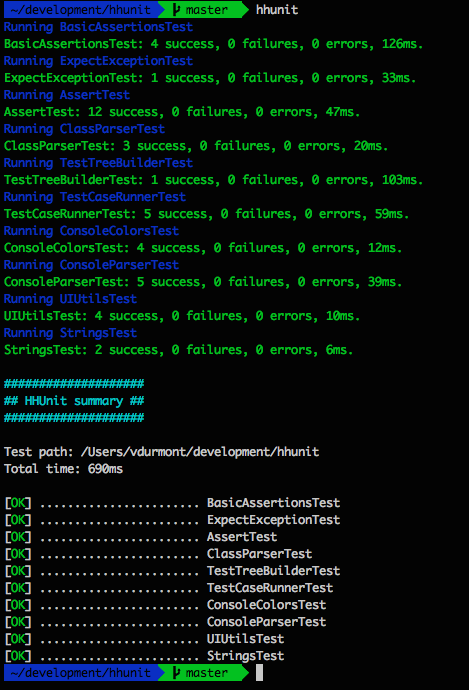Testing framework for Hack.
Disclaimer: This is a "quick'n'dirty" project that I created while learning Hack and diving into PHP. There are A LOT of things to do before using it in a real production environment :)
- Install and run
- My first test
- More examples
- Testing lifecycle
- Extending HHUnit
- Contributing
- License
You should have hhvm running on your computer.
We will soon publish a beta version on composer. In the meantime, you should clone this repository and create an alias to the hhunit file:
git clone git@github.com:vdurmont/hhunit.git ~/.hhunit
alias hhunit="hhvm ~/.hhunit/hhunit"
Run with:
hhunit [testPath]
testPath is optional. If not provided, the current working directory will be used as a test path.
Let's say you have a class like this one:
<?hh // strict
class MyCalculator {
public static function add(int $a, int $b) : int {
return $a + $b;
}
}Here is a simple test (the class must have the HHUnit attribute):
<?hh // strict
use \HHUnit\Assert\Assert;
use \HHUnit\Core\ClassLoader;
<<HHUnit>>
class MyCalculatorTest {
<<SetUpClass>>
public static function setUpClass() : void {
ClassLoader::loadClass(__DIR__."/MyCalculator.hh");
}
<<Test>>
public function add_with_2_positive_integers() : void {
$result = MyCalculator::add(3, 4);
Assert::equals(7, $result);
}
}Let's run it:
hhunit /path/to/MyCalculatorTest.hhYou can find examples in the examples folder.
Here is how HHUnit works:
- (1) HHUnit will search recursively in the
testPathdirectory for files namedHHUnitSetUp.hh. If some are found, they will be executed. - (2) For each TestSuite:
- (2.1) If your TestSuite has a method with a
<<SetUpClass>>attribute, it will be executed. - (2.2) For each TestCase:
- (2.2.1) If your TestSuite has a method with a
<<SetUp>>attribute, it will be executed. - (2.2.2) The TestCase method (with a
<<Test>>attribute) will be executed. - (2.2.3) If your TestSuite has a method with a
<<TearDown>>attribute, it will be executed.
- (2.2.1) If your TestSuite has a method with a
- (2.3) If your TestSuite has a method with a
<<TearDownClass>>attribute, it will be executed.
- (2.1) If your TestSuite has a method with a
- (3) HHUnit will search recursively in the
testPathdirectory for files namedHHUnitTearDown.hh. If some are found, they will be executed.
If the file exists, it will be executed before all the tests. Here are a few examples of what you could do there:
- Change the internal configuration of HHUnit (Runners, IFileService...)
- Start your database server
- Create a directory to store temporary files
- Register your
spl_autoload - // TODO other ideas?
If you defined this method, it will be executed before running the TestSuite. Here are a few examples of what you could do there:
- Create a new database
- Check if the database state is clean
- Load the classes you need for this TestSuite
- // TODO other ideas?
If you defined this method, it will be executed before running each TestCase. Here are a few examples of what you could do there:
- Check if the database state is clean
- Instantiate some common objects you use in the tests
- // TODO other ideas?
Just write your test :)
If you defined this method, it will be executed after running each TestCase. Here are a few examples of what you could do there:
- Clean the database
- Reset some common objects you use in the tests
- // TODO other ideas?
If you defined this method, it will be executed after running the TestSuite. Here are a few examples of what you could do there:
- Delete a database
- Unload classes
- // TODO other ideas?
If the file exists, it will be executed after all the tests. Here are a few examples of what you could do there:
- Stop your database server
- Clean some temporary directories
- // TODO other ideas?
If you have the following hierarchy:
<testPath>
|- HHUnitSetUp.hh
|- HHUnitTearDown.hh
|- MyFirstTest.hh
|- MySecondTest.hh
|- folder1
| |- HHUnitSetUp.hh
| |- HHUnitTearDown.hh
| |- MyFirstSubTest.hh
| \- MySecondSubTest.hh
|
\- folder2
\- MyThirdSubTest.hh
The execution flow will be:
<testPath>/HHUnitSetUp.hh
<testPath>/MyFirstTest.hh
<testPath>/MySecondTest.hh
<testPath>/folder1/HHUnitSetUp.hh
<testPath>/folder1/MyFirstSubTest.hh
<testPath>/folder1/MySecondSubTest.hh
<testPath>/folder1/HHUnitTearDown.hh
<testPath>/folder2/MyThirdSubTest.hh
<testPath>/HHUnitTearDown.hh
// TODO write me
// TODO write me
Check out LICENSE.md.
